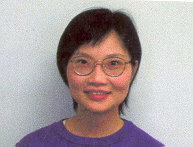Shu-Chan Hsu, PhD, Rutgers University

The research goal of Dr. Shu-Chan Hsu's lab is to define the biochemical events underlying neurite outgrowth. The lab has identified two protein complexes, the exocyst (sec6/8) complex and the sep2/4/6/7/8 family, both of which are required for promoting and regulating neurite outgrowth. Currently, the lab is using molecular biological, biochemical, immunochemical, electrophysiological and cell biological techniques to investigate the molecular mechanisms of these two complexes in regulating neurite development, axon/dendritic differentiation and synapse formation. In addition, the lab is using these two complexes as molecular handles to identify and isolate other protein players in the neurite outgrowth process. Elucidation of the molecular events underlying neurite outgrowth should provide important insights into the regulation of neuronal growth, differentiation and regeneration.
 Part of The Investigator's Annexe program.
Part of The Investigator's Annexe program.
Products
References
- Chernyshova Y, Leshchyns'ka I, Hsu SC, Schachner M, Sytnyk V. (2011) The neural cell adhesion molecule promotes FGFR-dependent phosphorylation and membrane targeting of the exocyst complex to induce exocytosis in growth cones. J. Neurosci 31:3522-3535.
- Liu J, Zuo X, Yue P, Guo W (2007) Phosphatidylinositol 4,5-bisphosphate mediates the targeting of the exocyst to the plasma membrane for exocytosis in mammalian cells. Mol Biol Cell. 18:4483-4492.
- Oztan A, Silvis M, Weisz OA, Bradbury NA, Hsu SC, Goldenring JR, Yeaman C, Apodaca G. (2007) Exocyst requirement for endocytic traffic directed toward the apical and basolateral poles of polarized MDCK cells. Mol Biol Cell. 10:3978-3992.
- Zuo X, Zhang J, Zhang Y, Hsu SC, Zhou D, Guo W. (2006) Exo70 interacts with the Arp2/3 complex and regulates cell migration. Nat Cell Biol. 2006 8:1383-1388.
- Ewart MA, Clarke M, Kane S, Chamberlain LH, Gould GW. (2005) Evidence for a role of the exocyst in insulin-stimulated Glut4 trafficking in 3T3-L1 adipocytes. J Biol Chem. 280:3812-3816.
- Wang L, Li G, Sugita S. (2004) RalA-exocyst interaction mediates GTP-dependent exocytosis. J Biol Chem. 279:19875-19881.
- Fukai S, Matern HT, Jagath JR, Scheller RH, Brunger AT (2003) Structural basis of the interaction between RalA and Sec5, a subunit of the sec6/8 complex. EMBO J. 22:3267-78.
- Wang, S. and Hsu, S.-C. (2003) Immunological Characterization of Exocyst Complex Subunits in Cell Differentiation. Hybridoma 22: 159-164.
- Sugihara K, Asano S, Tanaka K, Iwamatsu A, Okawa K, Ohta Y (2002) The exocyst complex binds the small GTPase RalA to mediate filopodia formation. Nat Cell Biol. 4:73-8.
- Vega, I. and Hsu, S.-C. (2001) The Exocyst complex associates with microtubules to mediate vesicle targeting and neurite outgrowth. J. Neurosci. 21: 3839-3848.
- >Brymora A, Valova VA, Larsen MR, Roufogalis BD, Robinson PJ (2001) The brain exocyst complex interacts with RalA in a GTP-dependent manner: identification of a novel mammalian Sec3 gene and a second Sec15 gene. J Biol Chem. 276:29792-29797.



